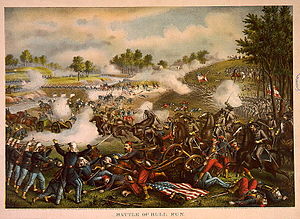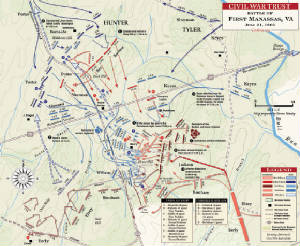|
General Evans 1st Battle of Manassas / First Battle of Bull Run
General Nathan G. Evans' Official Report for the Battle of First Manassas
| 1st Battle of Manassas |

|
| First Battle of Manassas |
HEADQUARTERS STONE BRIDGE, BULL RUN, VA.,
July
24, 1861.
Col. PHILIP ST. GEORGE COCKE,
Commanding Fifth Brigade.
COLONEL: I have the honor herewith
to submit the reports of Col. J. L. E. Sloan, commanding Fourth Regiment of South Carolina Volunteers; Captain Harris, commanding
the First Special Battalion Louisiana Volunteers; Captain Terry, commanding the squadron of cavalry, and First Lieutenant
Davidson, commanding a section of Latham's battery of artillery, the whole constituting the force under my command on the
21st instant.
The enemy made his appearance in line of battle on the east side
of the stone bridge, about fifteen hundred yards in front of my position, and opened their fire with rifled cannon at 5.15
a.m., which was continued at intervals for about an hour. Having my entire force covered by the crest of the hills on the
west side of the bridge, I did not return the fire. Observing the enemy had deployed a considerable force as skirmishers in
front of his line, and that they were advancing on my position, I directed the two flank companies of the Fourth Regiment
South Carolina Volunteers and one company of Major Wheat's Special Battalion Louisiana Volunteers to advance as skirmishers,
covering my entire front.
The skirmishers were soon engaged, and kept up a
brisk fire for about an hour, when I perceived that it was not the intention of the enemy to attack me in my present position,
but had commenced his movement to turn my left flank. I at once decided to quit position and to meet him in his flank movement,
leaving the skirmishers of the Fourth Regiment of South Carolina Volunteers, supported by the reserve of two companies, to
keep him engaged. I sent word to Col. Philip St. George Cocke that I had abandoned my position at the bridge, and was advancing
to attack the enemy at the crossing of the Warrenton turnpike and the Manassas roads.
Observing carefully the movements of the enemy, I was able to form my line of attack directly in his front, covered by a grove
of woods, at about 9 o'clock a.m. Placing the Fourth Regiment on the left, supported by one piece of artillery, Major Wheat
on the right, supported by a company of cavalry, I directed my command to open fire as soon as the enemy approached within
range of muskets. At 9.15 o'clock my command opened a vigorous fire from their position, which caused the enemy to halt in
confused order. The fire was warmly kept up until the enemy seemed to fall back. Major Wheat then made a charge with his whole
battalion.
At this juncture General Bee arrived with his brigade to my timely
assistance, and formed immediately in my rear, and advanced, covering and relieving my command, and was immediately hotly
engaged with the enemy. Col. F. S. Bartow, with his regiment (Eighth Georgia), came up soon after to the support of General
Bee, but the enemy by this time were in such large force that our position was no longer tenable, and I ordered my command,
now greatly scattered, to fall back under cover towards the Lewis house. The commands of General Bee and myself were now completely
scattered, when we were timely covered by Hampton's Legion and other re-enforcements.
For the further services of my command I beg to refer you to the inclosed reports. While my whole command gallantly charged
and repulsed the enemy, I would call the attention of the general commanding to the heroic conduct of Maj. Robert Wheat, of
the Louisiana Volunteers, who fell, gallantly leading his men in a charge, shot through both lungs. I am also much indebted
to him for his great experience and excellent advice. Colonel Sloan was observed by me several times during the day rallying
his men and bravely leading them to action.
For acts of particular gallantry
I beg again to refer to the reports of the immediate commanders. Lieutenant Davidson, though with one of his pieces crippled,
did gallant service during the entire day, and kept up a brisk fire upon the enemy as they advanced to within two hundred
yards of his piece. To my personal staff I am greatly indebted for the promptness with which they bore my orders under heavy
fire, and to Capts. George McCausland, Alexander Rogers, aides-de-camp, and A. L. Evans, acting assistant adjutant-general,
I am particularly indebted for remaining with me under heavy fire during the entire day.
I send herewith a stand of colors taken during the action by Major Wheat's battalion. I would also call the attention of the
commanding general to the valuable services of Dr. Bronaugh, of Virginia, who conducted me to the ground and assisted me in
selecting my position to commence the action.
Very respectfully, your obedient servant,
N. G. EVANS,
Brigadier-General, Commanding.
| Civil War Battle of Manassas Map |

|
| Civil War Battle of 1st Manassas Map |
|

